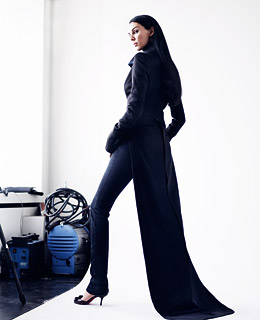
Six-foot-three L'Wren Scott left Roy, Utah, in September 1985 to become a model in Paris, and since then she has led a star-studded life. In Paris she befriended the designers she worked with, including Karl Lagerfeld and Thierry Mugler. She landed jobs as a hosiery model and hardly escaped notice: she was Pretty Polly and the leggy Dim Up girl in the talked-about campaign shot by renowned photographer Jean-Paul Goude.
In 1994 Scott, now 41, moved to California and became a stylist for celebrity photographer Herb Ritts, before branching out on her own to dress megastars like Nicole Kidman. In 2001 Scott met Mick Jagger, purportedly at a photo shoot, and today they often share a suite in a chic Manhattan hotel with expansive views of Central Park. She loves gemstones and fur and to be driven around town in limos. Scott loves the best of the best.
But she also loves to work, and in 2006 Scott decided to launch her own line of clothing. "In Paris no one was more obsessed than I was with what was going on behind the scenes," Scott recalls. "I became friendly with the patternmakers and obsessed with how clothes are made. After working with clothes for so long, it seemed right to design them."
Her collection offers women the understated glamour that was her signature in Hollywood. Her ruffled silk blouses ($1,100), Sophia Loren-style strapless dresses ($1,400) and jeans ($985)—cut long and lean, just like her—sell at specialty retailers like Barneys and Maxfield's. This year she designed the extraordinary diamond necklace that Kidman wore to the Oscars. It was made of 7,645 stones, totaling nearly 1,400 carats, and its value is a well-guarded secret.
But ask Scott to define luxury, and she has trouble. "Luxury is a state of mind," she says. "Random things are luxurious to people. It's personal."
Scott's collection—a favorite of Sarah Jessica Parker and Penélope Cruz—is part of a new niche in luxury clothing. "L'Wren has tapped into a key idea in luxury dressing now: spend the money, yes, but wear the clothes year after year," says Julie Gilhart, the fashion director of Barneys. "Luxury today is nonexcessive. It's a luxury you can't see."
Scott follows in the footsteps of a handful of female designers who have built big businesses by marketing their own style. Donna Karan offered a system of dressing that began in 1985 with seven easy pieces. Diane von Furstenberg made the cover of Newsweek in 1976 with her famed wrap dress, which gave working women effortless style.
While Scott's business is small, she too wants to make getting dressed effortless. "My collection is based on a one-color palette," she says. She relies mainly on fabrics like silk jacquards and lightweight wools and adds drama in the cut. And with a staff of only four, she is involved in every phase of her business, even spending weeks at a time at her factories in Italy and France. "I'm not the first in line," she says, "but I am the one standing there making it perfect." —Josh Patner